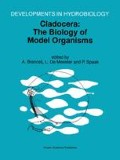Abstract
Using a clone that responds to the presence of fish kairomones by a pronounced change in phototactic behaviour, we determined how fast a change to more negatively phototactic behaviour occurs in Daphnia magna adults that are exposed to a high concentration of fish kairomones. Kairomone exposed animals showed an approximately linear decrease in the value of the phototactic index with time. Though the response was almost immediate, it took two hours before the difference between fish-induced and control animals was significant. Extrapolation of the observed response indicates that a maximal change in phototactic behaviour, equivalent to animals that have been cultured in the presence of fish kairomones since birth, occurs after about 13 hours exposure. We conclude that the predator-induced change in diel vertical migration of Zooplankton is fast, and is fully developed in less than a day. The response time to fish kairomones of Daphnia is shorter for phototactic behaviour than for life history traits, which may have important consequences with respect to the evolution of trait-dependence in induced defence responses.
Access this chapter
Tax calculation will be finalised at checkout
Purchases are for personal use only
Preview
Unable to display preview. Download preview PDF.
References
Adler, F. R. & C. D. Harvell, 1990. Inducible defenses, phenotypic variability and biotic environments. Trends Ecol. Evol. 5: 407–410.
De Meester, L., 1991. An analysis of the phototactic behaviour of Daphnia magna clones and their sexual descendants. Hydrobi-ologia 225: 217–227.
De Meester, L., 1993. Genotype, fish-mediated chemicals and phototaxis in Daphnia. Ecology 74: 1467–1474.
De Meester, L., 1996. Evolutionary potential and local genetic differentiation in a phenotypically plastic trait of a cyclical parthenogen, Daphnia magna. Evolution 50: 1293–1298.
De Meester, L. & J. Pijanowska, 1997. On the trait-specificity of the response of Daphnia genotypes to the chemical presence of a predator. In Lenz, P. H., D. K. Hartline, J. E. Purcell & D. L. Macmillan (eds), Zooplankton: Sensory Ecology and Physiology. Gordon and Breach Publishers, Amsterdam: 407–417.
Forward, R. B. Jr. & D. Rittschof, 1993. Activation of photorespons-es of brine shrimp nauplii involved in diel vertical migration by chemical cues from fish. J. Plankton Res. 15: 693–701.
Harvell, C. D., 1990. The ecology and evolution of inducible defenses. Quart. Rev. Biol. 65: 323–340.
Havel, J. E. & S. I. Dodson, 1987. Reproductive costs of Chaoborus-induced polymorphism in Daphnia pulex. Hydrobiologia 150: 273–281.
Larsson, P. & S. Dodson, 1993. Chemical communication in plank-tonic animals. Arch. Hydrobiol. 129: 129–155.
Lively, C. M., 1986. Competition, comparative life histories, and maintenance of shell dimorphism in a barnacle. Ecology 67: 858–864.
Loose, C. J., 1993. Daphnia diel vertical migration behavior: response to vertebrate predator abundance. Arch. Hydrobiol., Beih. Ergebn. Limnol. 39: 29–36.
Loose, C. J. & P. Dawidowicz, 1994. Trade-offs in diel vertical migration by Zooplankton: the costs of predator avoidance. Ecology 75: 2255–2263.
Liming, J., 1994. Anti-predator defenses in Daphnia — are life-history changes always linked to induced neck spines? Oikos 69: 427–436.
Lynch, M. & R. Ennis, 1983. Resource availability, maternal effects and longevity. Exp. Gerontol. 18: 147–165.
Padilla, D. K. & S. C. Adolph, 1996. Plastic inducible morphologies are not always adaptive: the importance of time delays in a stochastic environment. Evol. Ecol. 10: 105–117.
Parejko, K. & S. I. Dodson, 1990. Progress towards characterization of a predator/prey kairomone: Daphnia pulex and Chaoborus americanus. Hydrobiologia 198: 51–59.
Parejko, K. & S. I. Dodson, 1991. The evolutionary ecology of an antipredator reaction norm: Daphnia pulex and Chaoborus americanus. Evolution 45: 1665–1674.
Reede, T. & J. Ringelberg, 1995. The influence of a fish exudate on two clones of the hybrid Daphnia galeata × hyalina. Hydrobiologia 307: 207–212.
Riessen, H. P., 1984. The other side of cyclomorphosis: why Daphnia lose their helmets. Limnol. Oceanogr. 29: 1123–1127.
Riessen, H. P. & W. G. Sprules, 1990. Demographic costs of antipredator defenses in Daphnia pulex. Ecology 71:1536–1546.
Ringelberg, J., 1964. The positively phototactic reaction of Daphnia magna Straus — a contribution to the understanding of diurnal vertical migration. Neth. J. Sea Res. 2: 319–406.
Ringelberg, J. & H. Servaas, 1971. A circadian rhythm in Daphnia magna. Oecologia 6: 289–292.
Ringelberg, J. & E. van Gool, 1995. Migrating Daphnia have a memory for fish kairomones. Mar. Freshwat. Behav. Physiol. 26: 249–257.
Tollrian, R. & E. von Elert, 1994. Enrichment and purification of Chaoborus kairomone from water: further steps toward its chemical characterization. Limnol. Oceanogr. 39: 788–796.
Weider, L. J. & J. Pijanowska, 1993. Plasticity of Daphnia life histories in response to chemical cues from predators. Oikos 67: 385–392.
Author information
Authors and Affiliations
Editor information
Rights and permissions
Copyright information
© 1997 Springer Science+Business Media Dordrecht
About this paper
Cite this paper
De Meester, L., Cousyn, C. (1997). The change in phototactic behaviour of a Daphnia magna clone in the presence of fish kairomones: the effect of exposure time. In: Brancelj, A., De Meester, L., Spaak, P. (eds) Cladocera: the Biology of Model Organisms. Developments in Hydrobiology, vol 126. Springer, Dordrecht. https://doi.org/10.1007/978-94-011-4964-8_19
Download citation
DOI: https://doi.org/10.1007/978-94-011-4964-8_19
Publisher Name: Springer, Dordrecht
Print ISBN: 978-94-010-6084-4
Online ISBN: 978-94-011-4964-8
eBook Packages: Springer Book Archive

